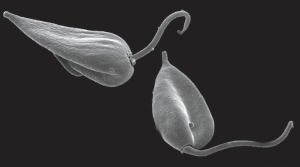Literatura
1Cannon Des (2015) Bee colonies wiped out as ne parasite spreads through New Zealand. The Australasian Beekeeper 117 (6): 245.
2Borowik O a Goodwin M (2015) Honey Bee Parasite Lotmaria passim Identified in New Zealand. The New Zealand Beekeeper 23 (7): 9-.
3Langridge D a McGhee R (1967) Crithidia mellificae, an acidophilic trypanosomatide of honey bee Apis mellifera. The Journal of Protozoology 14 (3): 485–487.
4Schwarz RS, Bauchan GR, Murphy CA, Ravoet J, Graaf DC, Evans JD (2015) Characterization of Two Species of Trypanosomatidae from the Honey Bee Apis mellifera: Crithidia mellificae Langridge and McGhee, and Lotmaria passim n. gen., n. sp. Journal of Eukaryotic Microbiology 62 (5): 567-583.
5Runckel C, Flenniken ML, Engel JC, Ruby JG, Ganem D, Andino R, DeRisi JL (2011) Temporal analysis of the honey bee microbiome reveals four novel viruses and seasonal prevalence of known viruses, Nosema, and Crithidia. PloS One 6 (6): e20656.http:///h
6Cornman RS, Tarpy DR, Chen Y, Jeffreys L., Lopez D., Pettis JS, ... & Evans JD (2012) Pathogen webs in collapsing honey bee colonies. PLoS One 7 (8): e43562.
7Morimoto T, Kojima Y, Yoshiyama M, Kimura K, Yang B, et al. (2013) Molecular detection of protozoan parasites infecting Apis mellifera colonies in Japan. Environmental Microbiology Reports 5 (1): 74–77
8Yang B, Peng GD, Li TB, Kadowaki T (2013) Molecular and phylogenetic characterization of honey bee viruses, Nosema microsporidia, protozoan parasites, and parasitic mites in China. Ecology and Evolution 3: 298–311.
9Dainat B, Evans JD, Gauthier L, Neumann P (2012) Crithidia mellifcae is widespread in Europe and can be used as a predictive marker of honeybee colony losses. In: Barth B, Scharpenberg H, Moritz RFA (ed.) 5th European Conference of Apidology.
10Ravoet J, Maharramov J, Meeus, I, De Smet L, Wenseleers T, Smagghe G, de Graaf DC (2013) Comprehensive bee pathogen screening in Belgium reveals Crithidia mellificae as a new contributory factor to winter mortality. PLoS One 8 (8): e72443.
11Schwarz RS a Evans JD (2013) Single and mixed-species trypanosome and microsporidia infections elicit distinct, ephemeral cellular and humoral immune responses in honey bees. Developmental and Comparative Immunology 40 (3-4): 300–310.
12Brown MJF, Loosli R, Schmid-Hempel P (2000) Condition-dependent expression of virulence in a trypanosome infecting bumblebees. Oikos 91 (3): 421–427
